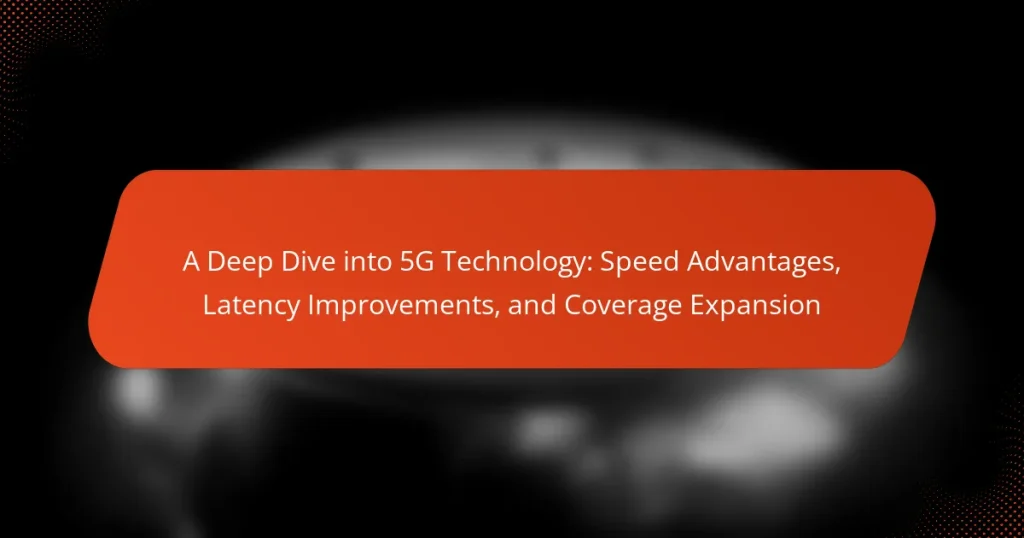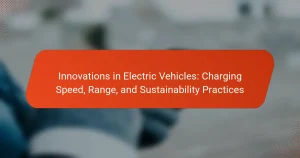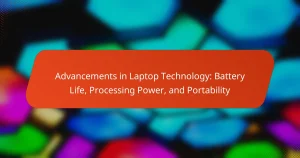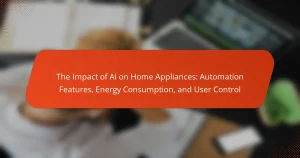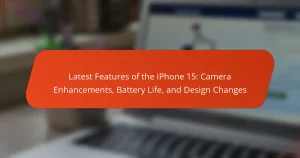5G technology is the fifth generation of mobile network technology, offering data speeds up to 10 Gbps and reduced latency often below 10 milliseconds. This advancement enhances real-time communication for applications such as gaming and video conferencing while supporting a higher number of connected devices, which is vital for the Internet of Things (IoT). The robust infrastructure of 5G includes advanced base stations, fiber optic networks, and small cell technology, all contributing to improved data transmission. The impact of 5G spans various industries, enabling innovations in healthcare, automotive, manufacturing, and entertainment through its speed advantages and low latency.
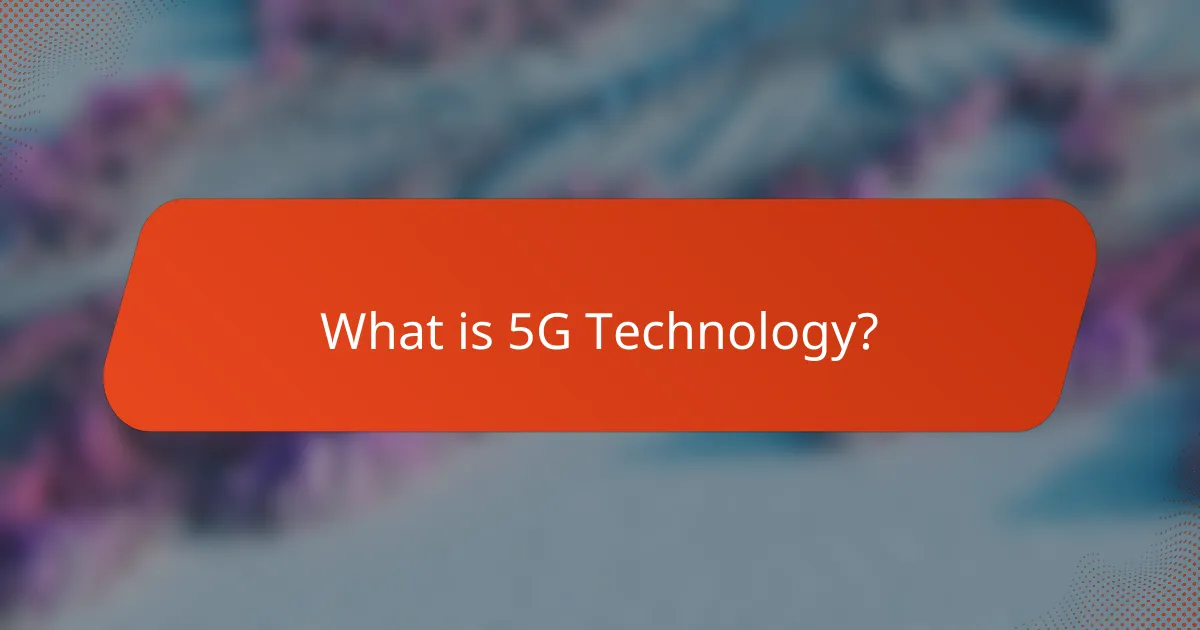
What is 5G Technology?
5G technology is the fifth generation of mobile network technology. It provides significantly faster data speeds compared to previous generations. 5G can achieve speeds up to 10 Gbps, enabling quicker downloads and streaming. This technology also offers reduced latency, often below 10 milliseconds. Such low latency enhances real-time communication for applications like gaming and video conferencing. Additionally, 5G networks support a higher number of connected devices simultaneously. This capability is crucial for the Internet of Things (IoT) expansion. Overall, 5G technology represents a major advancement in mobile connectivity.
How does 5G Technology differ from previous generations?
5G technology differs from previous generations primarily in speed, latency, and capacity. It offers download speeds up to 10 Gbps, significantly faster than 4G’s maximum of 1 Gbps. Latency in 5G can be as low as 1 millisecond, compared to 30-50 milliseconds in 4G. 5G supports a higher density of devices, allowing over 1 million devices per square kilometer, while 4G supports around 100,000. The technology utilizes advanced techniques like millimeter waves and massive MIMO, enhancing overall performance. These advancements enable new applications such as autonomous vehicles and smart cities, which were not feasible with earlier generations.
What are the key technical advancements in 5G?
Key technical advancements in 5G include enhanced mobile broadband, ultra-reliable low latency communication, and massive machine-type communications. Enhanced mobile broadband offers download speeds exceeding 10 Gbps. This is a significant increase compared to 4G speeds, which typically max out around 1 Gbps. Ultra-reliable low latency communication reduces latency to as low as 1 millisecond. This improvement supports applications like remote surgery and autonomous vehicles. Massive machine-type communications enable a million devices to connect per square kilometer. This capability supports the Internet of Things (IoT) on a large scale. 5G also utilizes advanced technologies like MIMO (Multiple Input Multiple Output) and beamforming. These technologies enhance signal quality and network efficiency. Overall, these advancements significantly improve connectivity, speed, and reliability.
How do these advancements impact user experience?
Advancements in 5G technology significantly enhance user experience. Increased speed allows for quicker downloads and smoother streaming. Users can access high-definition content without buffering. Reduced latency improves real-time interactions in applications like gaming and video conferencing. This results in more responsive applications. Expanded coverage ensures connectivity in previously underserved areas. Users experience fewer dropped connections and better service reliability. Overall, these advancements lead to a more seamless and efficient digital experience.
What are the primary components of 5G Technology?
The primary components of 5G technology are radio access networks, core networks, and user equipment. Radio access networks consist of small cells and macro cells that facilitate wireless communication. Core networks manage data traffic and connectivity between devices. User equipment includes smartphones and IoT devices that utilize 5G connectivity. Additionally, 5G technology employs millimeter waves, Massive MIMO, and beamforming for enhanced performance. These components work together to deliver faster speeds, lower latency, and improved coverage compared to previous generations.
What role do antennas play in 5G networks?
Antennas are crucial components in 5G networks. They facilitate the transmission and reception of radio signals. 5G networks utilize multiple-input multiple-output (MIMO) technology. This technology employs numerous antennas to improve capacity and performance. The use of higher frequency bands in 5G requires advanced antenna designs. Beamforming is a technique used to direct signals toward specific users. This enhances signal strength and reduces interference. Antennas contribute to the overall network efficiency and user experience. Studies indicate that optimized antenna configurations can significantly boost data rates.
How does the infrastructure support 5G connectivity?
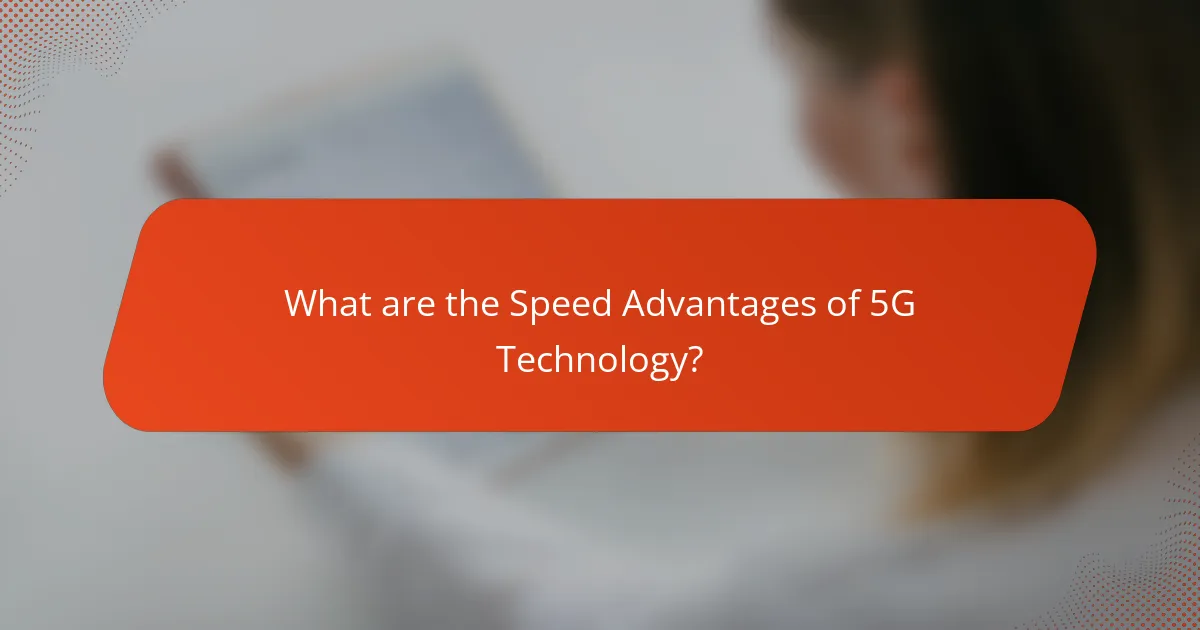
What are the Speed Advantages of 5G Technology?
5G connectivity is supported by a robust infrastructure that includes advanced base stations, fiber optic networks, and small cell technology. These elements work together to enhance data transmission speeds and reduce latency. Base stations are equipped with multiple antennas and support higher frequency bands, enabling faster data rates. Fiber optic networks provide the necessary backbone for high-speed data transport between base stations and the core network. Small cell technology complements this by filling coverage gaps in urban areas, allowing for denser network deployment. According to the GSMA, 5G can achieve speeds up to 10 Gbps, significantly surpassing 4G capabilities. This infrastructure is essential for delivering the promised speed advantages of 5G technology.
How much faster is 5G compared to 4G?
5G is significantly faster than 4G, with speeds potentially reaching up to 10 Gbps. In contrast, 4G typically offers speeds of around 100 Mbps to 1 Gbps. This means 5G can be up to 100 times faster than 4G in optimal conditions. The enhanced speed of 5G results from advanced technologies like millimeter waves and massive MIMO. These technologies enable greater data transfer rates and improved network efficiency. Studies indicate that 5G’s higher bandwidth allows for more simultaneous connections. This capability is crucial for supporting the growing number of devices in the Internet of Things (IoT).
What factors contribute to the increased speed of 5G?
The increased speed of 5G is primarily due to higher frequency bands, advanced antenna technology, and network densification. Higher frequency bands, such as millimeter waves, allow for greater data transmission rates. Advanced antenna technologies like Massive MIMO enable multiple data streams simultaneously. Network densification involves more base stations, reducing distance to users and improving signal quality. These factors collectively enhance the overall capacity and speed of 5G networks. Studies show that 5G can achieve speeds exceeding 10 Gbps under optimal conditions.
How does speed affect different applications?
Speed significantly impacts various applications by enhancing performance and user experience. In mobile gaming, faster speeds reduce latency, resulting in smoother gameplay. For video streaming, higher speeds enable higher resolution content without buffering. In IoT devices, increased speed allows for quicker data transmission, improving real-time analytics. For telemedicine, speed enhances video quality and reduces delays during consultations. In autonomous vehicles, rapid data exchange is crucial for real-time decision-making. According to a study by the GSMA, 5G technology can provide speeds up to 10 Gbps, enabling these advancements across applications.
What are the practical implications of 5G speed in daily life?
5G speed significantly enhances daily life by enabling faster data transfer and improved connectivity. Users experience quicker downloads and uploads, reducing waiting times for streaming and file sharing. This speed facilitates seamless video conferencing and online gaming, enhancing user experiences. Smart home devices benefit from 5G, allowing real-time communication and control. In transportation, 5G supports autonomous vehicles by providing rapid data exchange for navigation and safety. Healthcare applications, such as remote surgeries, rely on 5G for low-latency communication. According to a report by Ericsson, 5G can deliver speeds up to 10 Gbps, transforming how people interact with technology daily.
How can consumers benefit from faster internet speeds?
Consumers can benefit from faster internet speeds through improved streaming quality and reduced buffering. This enhancement allows for seamless viewing of high-definition content. Faster speeds also enable quicker downloads and uploads of files. For example, a 1GB file can be downloaded in seconds with high-speed internet. Enhanced online gaming experiences are another advantage. Gamers experience lower latency and faster response times. Additionally, faster internet supports multiple devices simultaneously without slowdowns. This is essential as households increasingly rely on smart devices. Overall, faster internet speeds significantly enhance user experience across various online activities.
What industries are revolutionized by 5G speed advantages?
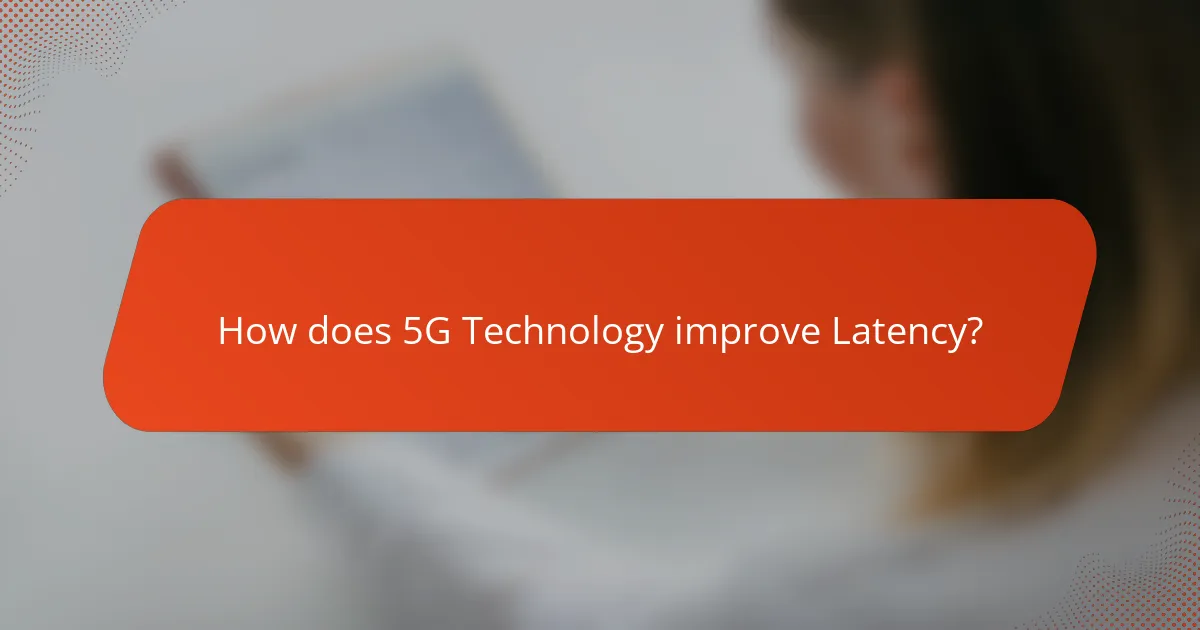
How does 5G Technology improve Latency?
5G speed advantages revolutionize several industries, including healthcare, automotive, manufacturing, and entertainment. In healthcare, 5G enables remote surgeries and real-time patient monitoring with minimal delay. The automotive industry benefits from enhanced vehicle-to-everything communication, improving safety and efficiency. Manufacturing sees increased automation and real-time data analytics, leading to optimized production processes. The entertainment sector experiences higher-quality streaming and immersive experiences through augmented and virtual reality. These advancements are driven by 5G’s ability to support high data rates and low latency, facilitating innovative applications across these industries.
What is latency and why is it important in telecommunications?
Latency is the time delay experienced in a telecommunications system. It is measured in milliseconds (ms) and affects the speed of data transmission. Low latency is crucial for real-time applications like video conferencing and online gaming. High latency can lead to delays, causing disruptions in communication. In 5G technology, latency can be as low as 1 ms. This improvement enhances user experience and supports advanced applications like autonomous vehicles. Therefore, latency is a key factor in determining the effectiveness of telecommunications networks.
How does 5G reduce latency compared to earlier technologies?
5G reduces latency compared to earlier technologies by utilizing advanced network architecture and technologies. It employs techniques like edge computing, which processes data closer to the user. This minimizes the distance data must travel, resulting in quicker response times. Additionally, 5G networks use higher frequency bands, allowing for faster data transmission. The theoretical latency of 5G is as low as 1 millisecond, compared to 30-50 milliseconds for 4G. This significant improvement enables real-time applications like autonomous driving and remote surgery. Overall, the combination of these technologies leads to a marked reduction in latency.
What are the implications of lower latency for real-time applications?
Lower latency enhances the performance of real-time applications significantly. It reduces the delay between user actions and system responses. This improvement is crucial for applications like online gaming, video conferencing, and autonomous vehicles. In gaming, lower latency results in smoother gameplay and quicker reaction times. For video conferencing, it leads to more natural conversations with minimal lag. In autonomous vehicles, lower latency enables faster decision-making, enhancing safety. Studies show that 5G technology can achieve latency as low as 1 millisecond, compared to 4G’s average of 30-50 milliseconds. This drastic reduction allows real-time applications to function more effectively and efficiently.
How does improved latency enhance user experiences?
Improved latency enhances user experiences by reducing the delay between user actions and system responses. This leads to more immediate feedback during online activities. For example, in gaming, lower latency allows for real-time interactions, enhancing competitiveness and enjoyment. In video conferencing, improved latency results in smoother conversations with fewer interruptions. Research indicates that a latency reduction from 100 ms to 20 ms can significantly improve user satisfaction. Users report less frustration and increased engagement with faster response times. Overall, enhanced latency fosters seamless interactions across various digital platforms.
In what ways does low latency benefit gaming and VR?
Low latency significantly enhances gaming and VR experiences. It reduces the time between user input and system response. This leads to more immersive and responsive gameplay. Gamers can react instantly to in-game actions. In VR, low latency minimizes motion sickness by synchronizing visuals with head movements. A study by Ericsson shows that latency below 20 milliseconds improves user experience in gaming. This responsiveness is crucial for competitive gaming environments. Overall, low latency fosters a seamless interaction between players and the virtual environment.
What are the potential impacts on remote work and telemedicine?
How does 5G Technology expand Coverage?
5G technology positively impacts remote work and telemedicine by enhancing connectivity and reducing latency. This improved connectivity allows for seamless video conferencing and real-time collaboration among remote teams. In telemedicine, 5G enables high-definition video consultations, which improve patient-provider interactions. Faster data transfer rates facilitate quicker access to medical records and imaging, streamlining healthcare delivery. A study by the GSMA predicts that 5G will enable a 10-fold increase in mobile broadband speeds, significantly benefiting both sectors. Additionally, 5G’s lower latency, around 1 millisecond, enhances the responsiveness of telehealth applications. This ensures timely interventions and better patient outcomes.
What are the strategies used to enhance coverage in 5G networks?
Strategies to enhance coverage in 5G networks include deploying small cells, utilizing beamforming technology, and implementing network slicing. Small cells improve coverage by providing localized signal boosts in high-demand areas. Beamforming directs signals toward specific users, enhancing signal strength and reducing interference. Network slicing allows for the creation of virtual networks tailored to specific applications, optimizing resource allocation. These strategies collectively address coverage challenges in urban and rural environments. Research indicates that small cell deployment can increase network capacity by up to 100 times in dense areas.
How does the deployment of small cells affect coverage?
What are the challenges in implementing 5G Technology?
The deployment of small cells significantly enhances coverage in urban areas. Small cells are low-powered cellular radio access nodes. They fill coverage gaps and improve network capacity. By being deployed closer to users, they reduce the distance signals must travel. This results in better signal quality and higher data speeds. According to a study by the 5G Americas organization, small cells can increase network capacity by up to 100 times. They are essential for supporting the high demand for data in densely populated regions. Overall, small cells are crucial for achieving comprehensive 5G coverage.
What technical hurdles must be overcome for widespread adoption?
Technical hurdles for widespread adoption of 5G technology include infrastructure development, spectrum allocation, and device compatibility. Infrastructure development requires significant investment in new base stations and fiber optics. Current 4G infrastructure is inadequate for 5G’s demands. Spectrum allocation involves regulatory challenges to secure necessary frequency bands. Many countries face delays in auctioning these frequencies. Device compatibility is crucial, as not all existing devices support 5G. Manufacturers must produce more 5G-capable devices to meet consumer demand. Additionally, network security concerns must be addressed to protect against potential vulnerabilities. These factors collectively hinder the rapid implementation of 5G technology.
How do regulatory issues impact the rollout of 5G?
What are the best practices for utilizing 5G Technology?
Regulatory issues significantly impact the rollout of 5G by creating barriers to deployment and affecting investment. Different countries have varying regulations that can delay infrastructure development. For example, the Federal Communications Commission (FCC) in the United States has streamlined processes for spectrum allocation, which can speed up deployment. Conversely, strict zoning laws can hinder the installation of necessary cell towers. Compliance with health and safety standards can also add time and costs to the rollout. Additionally, international trade regulations may affect the availability of equipment from manufacturers. Overall, regulatory frameworks shape the pace and efficiency of 5G implementation.
5G technology is the fifth generation of mobile network technology, offering significantly faster data speeds, reduced latency, and enhanced connectivity for a larger number of devices. This article examines the speed advantages of 5G, which can reach up to 10 Gbps, and its latency improvements, which can drop to as low as 1 millisecond, enabling real-time applications. Additionally, it discusses the infrastructure components that support 5G, the impact on user experience across various industries, and the challenges faced in implementing this advanced technology. Overall, the article provides a comprehensive overview of 5G technology’s capabilities and its transformative effects on connectivity.
